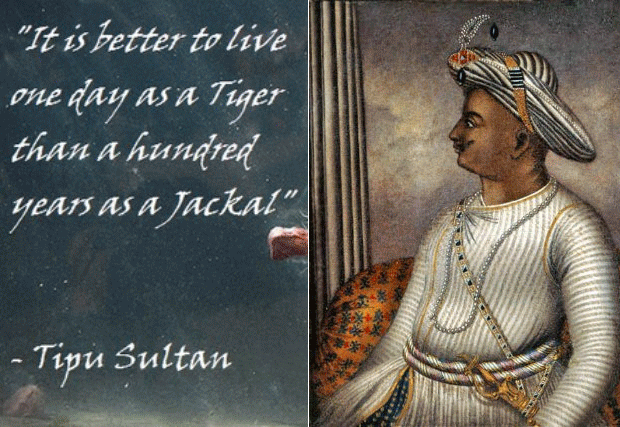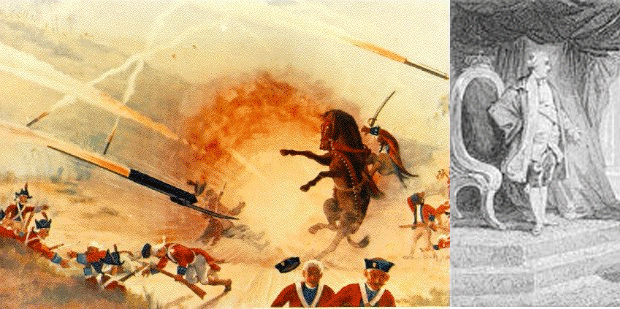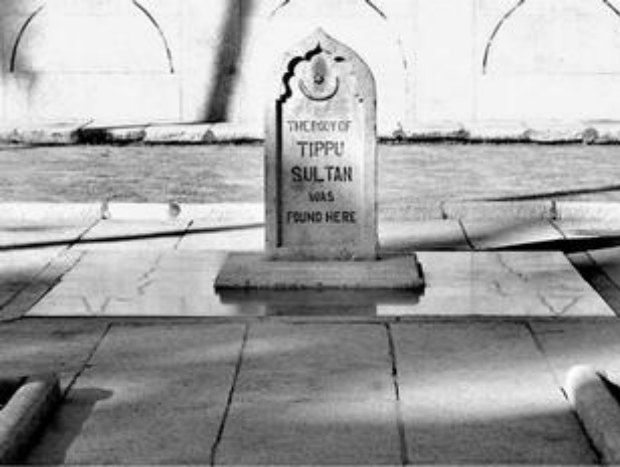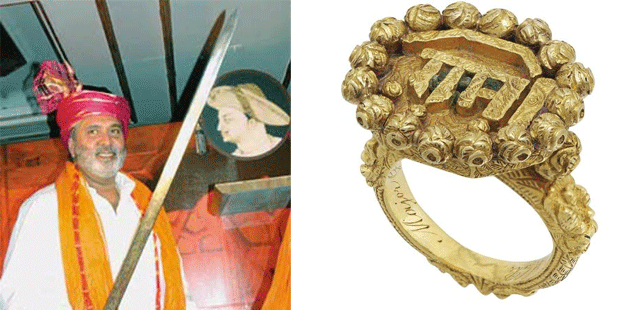|
“It is better to live one day as a Tiger than a
hundred years as a Jackal”
Tipu Sultan, prominently known as Sher-e-Mysore (Tiger of Mysore) is
also given the sobriquet of Sher-e-Hind and Sher-e-Mashriq (Tiger of the
East). A legendary ruler, he not only opposed British rule in South
India but also played a major role in keeping the British forces away
from South India. He was one of those rare rulers who had the gumption
to challenge the British Government.
No wonder, the mighty Tippoo Sahib (as addressed by British) defeated
the foreign invaders in the First and Second Anglo Mysore War and even
dictated terms to the British in the subsequent Treaty of Madras and
Mangalore respectively.
|
|
 |
|
Tipu Sultan, the Great Ruler of Mysore
After Hyder Ali died due to Carbuncle in the year 1782, Tipu became the
new ruler of Mysore. This new ruler who had already fought two wars –
First Anglo Mysore and Second Anglo Mysore War under the leadership of
his father knew that British forces were a great threat to the
independent Kingdom of Mysore. He therefore focused more on military
advances especially Mysorean rockets which were successfully used by his
father in the Second Anglo Mysore War against the British.
The Famous Mysore Rockets
Mysorean missiles were iron cased rockets fitted with swords in them.
These rockets used to travel long, covering various kilometers up in the
air before launching down - attacking the enemies with sword. Although
there were missiles in the Europe, Mysorean Missiles became famous due
to their coverage and destructive capacity. Hyder Ali’s Mysore rockets,
undoubtedly, were very advanced missiles than what the British had seen.
Tipu Sultan had written a Military Manual Fathul Mujahidin in which he
explained the operation of these Mysore Rockets. This was mainly due to
the iron tubes which were used for holding the rocket propellant. No
wonder, it enabled greater thrust and extended distance up to 2 km. |
|

|
|
Mysore Missiles, the Father of Congreve Rockets
In the year 1801, several of the Mysore rockets were sent to England in
the Royal Arsenal lab for R&D by Col. (Later Sir) William Congreve.
Roughly, 4 years later in the year 1805, Royal Arsenal came up with
their first Congreve rocket only due to the Technology devised by Haider
Ali and his son Tipu Sultan. These Congreve Rockets helped the British
troops in the Napolenic Wars and also in the War of 1812. Not to forget,
the Battle of Baltimore in the year 1814 was won mainly due to these
rockets. Congreve Rocket therefore was no brainchild of William Congreve
as widely considered. It is nothing but a modified version of Mysore
Rockets, invented by Haider Ali and widely used by Tipu Sultan, the
pioneer when it comes to utilizing rocket artillery. Congreve only did
what Mahesh Bhatt and Pritam do today.
A heart-breaking scene
Tipu was having lunch when he heard some clatter not far away. Sensing
some danger, he rushed to the scene like a fearless lion. What he saw
was a heat-breaking scene – The British had entered the fort unscathed.
Realizing the bitter truth that he and his men were victims of
cold-blooded betrayal, the Mysore Hero could have still escaped through
the secret pathways along with his family, like other kings have always
done in history. Or else he could have made peace signing a treaty and
thereby saving his and family’s life. But here lies the greatness of the
patriotic warrior of Indian independence. In midst of battle, he was
offered the chances for treaty with the British. But his chivalrous
reply became the slogan of bravery for all time to come: “One day’s life
of a lion is preferable to hundred years’ of a jackal”. |
|

|
|
The Fourth Anglo Mysore War that led to the Death
of Tipu Sultan
Srirangapatnam, the island fortress was the capital of Mysore during the
18th century. It was so well organized with good trade routes that
British feared terrible consequences. In addition, the ruler of Mysore
had an effective army as that of British army. This led to four wars
back to back. Although the first two wars were won by the Ruler of
Mysore, the third had dire consequences – Tipu’s two son aged 8 and 10
were detained by the British forces. Finally, in the fourth, Tipu Sultan
the ruler of Mysore breathed his last in 1799 at Srirangapatnam.
The Sword of Tipu Sultan
After the death of Tipu Sultan the British forces took away the Sword
and Ring of Tipu Sultan as war trophies. Both the remnants of Tipu
Sultan where displayed in the British Musuem till 2004 after which Vijay
Mallya, the liquor baron bought the sword of Tipu Sultan in an auction.
Tipu Sultan’s one of the very first swords which he lost during the wars
with the Nair of Travancore is displayed at Manchester Square, London. |
|
 |
|
Dishonesty and betrayal is something that destroys nation. If Tippu
Sultan had not been betrayed by Mir Jaffar and Mir Sadiq, the map of
Hindustan would be entirely different! Just imagine how many Mir Jaffers
and Mir Sadiqs are prevailing in our society, and how much destruction
they can cause to the Muslim community? Therefore, in order to survive,
Muslims should identify those snakes and crush their heads before it’s
too late!
|